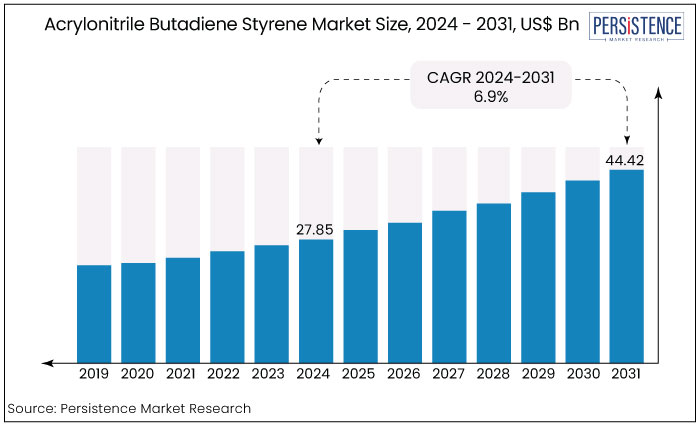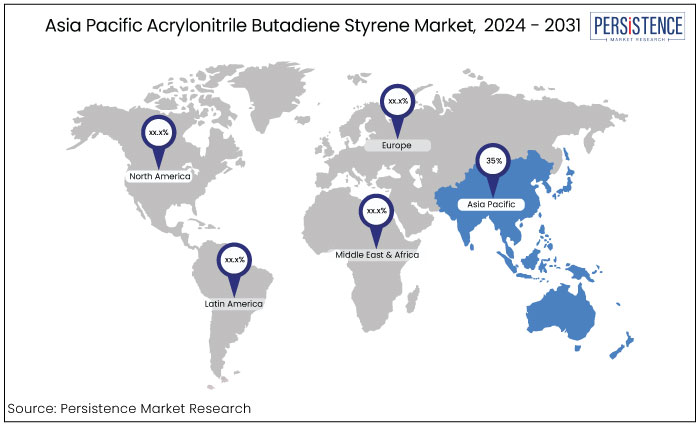Industry: Chemicals and Materials
Published Date: October-2024
Format: PPT*, PDF, EXCEL
Delivery Timelines: Contact Sales
Number of Pages: 188
Report ID: PMRREP34877
The acrylonitrile butadiene styrene market is estimated to increase from US$ 27.85 Bn in 2024 to US$ 44.42 Bn by 2031. The market is projected to record a CAGR of 6.9% during the forecast period from 2024 to 2031.
Increasing use in automotive, electronics, construction, and consumer goods sectors is anticipated to propel Acrylonitrile Butadiene Styrene (ABS) demand worldwide. Rising demand for lightweight yet robust automotive parts like dashboards, wheel covers, and other interior and exterior components is another key driving factor.
KAMManufaktur, a Budapest-based automotive firm recently announced its team expansion plans to initiate the production of lightweight cars. Such initiatives by start-ups and well-established companies are set to create new opportunities.

Key Highlights of the Market
|
Market Attributes |
Key Insights |
|
Acrylonitrile Butadiene Styrene Market Size (2024E) |
US$ 27.85 Bn |
|
Projected Market Value (2031F) |
US$ 44.42 Bn |
|
Global Market Growth Rate (CAGR 2024 to 2031) |
6.9% |
|
Historical Market Growth Rate (CAGR 2019 to 2023) |
6.2% |
|
Region |
Market Share in 2024 |
|
Asia Pacific |
35% |
Asia Pacific is likely to dominate in the foreseeable future, generating around 35% of the acrylonitrile butadiene styrene market share in 2024. The region's flourishing automotive, electronics, and appliances sectors are expected to propel demand for ABS in the production of diverse components and products.
Ongoing construction activities and infrastructure development projects in countries like India and China are set to push the use of ABS in pipes and fittings. Enhanced cash flow and high government investments in large-scale infrastructure projects are also expected to drive demand for ABS in Asia Pacific.

China's well-established automobile sector, which is known for cost-effective yet high-quality components worldwide is another key factor pushing demand for ABS. Despite the recession, automotive production in the country continues to rise, fueled by rising per capita income. It is anticipated to result in a growing demand for automobiles in the domestic market, thereby augmenting ABS sales.
|
Category |
Market Share in 2024 |
|
Type- Opaque |
40% |
Based on type, the global market is classified into opaque, transparent, and colored ABS. Out of these, the opaque segment is anticipated to dominate the market over the forecast period.
Opaque ABS possesses certain physical features, including excellent chemical resistance, durability against aging, hardness, gloss, and rigidity. These are likely to contribute to its diverse automotive applications. It is also set to be utilized in several other applications, such as computer components, baggage cases, and aircraft parts.
Opaque ABS is projected to be used to deliver a sleek, durable surface with significant resistance to chemicals and ultraviolet radiation. Its hydrophobic properties have resulted in increased application in the automobile sector for the manufacturing of components such as bumpers, seats, dashboards, interior trims, headliners, center consoles, and lights. It is further anticipated to be utilized in vacuum construction and piping systems due to its superior mechanical strength and lightweight properties.
|
Category |
Market Share in 2024 |
|
Technology- Injection Molding |
28% |
Based on technology, the acrylonitrile butadiene styrene market is divided into extrusion, injection molding, blow molding, thermoforming, and 3D printing. Among these, the injection molding technology segment dominates the market.
Injection molding is likely to be favored due to its superior efficiency and cost-effectiveness in mass manufacturing. This method allows for the production of complicated and sophisticated three-dimensional components with exact precision.
The extensive use of injection molding technology across diverse sectors, such as automotive, electronics, and consumer goods, is set to propel demand for acrylonitrile butadiene styrene materials. The adaptability, ease of modification, and capacity to generate high-quality components further facilitate their significance in the industry, augmenting the market.
Acrylonitrile butadiene styrene products are projected to find extensive use in the electronics and automotive industries for the production of a wide range of components. Surging demand for ABS polymers correlates with the substantial need for plastics from the previously listed end-use sectors.
Increasing demand from the healthcare sector is further driving expansion of the ABS market. This is attributed to the rising need for medical devices like insulin pens, respiratory apparatus, and micro-implants.
Rising utilization of 3D printing technology, with ABS as a favored material owing to its superior mechanical qualities and user-friendliness, further promotes market expansion. The transition to miniaturization and intelligent electronics is projected to enhance the manufacturing of lightweight, durable, and high-performance components.
The production of bio-based ABS, achieved by incorporating renewable resources, is consequently improving the sustainability of the products. These are anticipated to help mitigate environmental issues, thereby aiding growth.
During the historical period, the acrylonitrile butadiene styrene market experienced steady growth, achieving a CAGR of 6.2%. It was driven by robust demand in key sectors, such as automotive, electronics, and construction.
The market benefited from the increasing production of consumer electronics and the growing focus of the automotive sector on lightweight materials to enhance fuel efficiency. However, supply chain disruptions, raw material price volatility, and environmental regulations impacted the market dynamics.
From 2024 to 2031, the ABS market is projected to witness a CAGR of 6.9%, which will likely be fueled by the rising demand for sustainable materials. In addition, increasing adoption of electric vehicles requiring lightweight materials and advancements in consumer electronics are set to push demand. Growing emphasis on recyclable and bio-based ABS solutions due to environmental concerns is projected to provide new opportunities for market players.
Asia Pacific is anticipated to continue to dominate through 2031. However, significant growth is set to be seen in North America and Europe, driven by strict sustainability policies.
High Demand for Lightweight Vehicles to Spur Sales of ABS
Rising customer desire for lightweight automobiles is projected to skyrocket innovations in the automotive sector, aiding demand for acrylonitrile butadiene polymer. The rapid rise in the global population has also led to an increased demand for efficient automobiles. Materials like ABS are utilized in automobiles for several purposes, including bumpers, exterior panels, and dashboards. For instance,
The advantageous characteristics of ABS are set to make it suitable for lightweight vehicle production, generating significant demand and driving market growth. Furthermore, expansion in additional industries, including appliance manufacturing, construction, consumer goods, and electronics, is projected to significantly contribute to growth.
The consumer electronics industry is another significant driver for acrylic butadiene styrene market growth. This is due to the extensive use of the material in the production of casings, housings, and components for products like smartphones, laptops, and household appliances.
Demand for sleek, durable, and aesthetically pleasing designs in electronics has made ABS a material of choice due to its superior moldability, high gloss finish, and impact resistance. With the global rise in smart home devices, wearable technology, and smartphones, the need for high-performance plastics has surged.
In Asia Pacific, countries like China, South Korea, and Japan, are witnessing rapid expansion in consumer electronics manufacturing, which directly boosts the ABS market. As electronic devices become more integral to daily life and technological innovation accelerates, the demand for ABS is anticipated to rise dramatically.
Emergence of Substitutes like Styrene-Butadiene Rubber May Restrict Growth
Acrylonitrile butadiene styrene has exhibited a significant rise in demand across multiple end-use sectors, resulting in the emergence of several substitutes. Substitutes such as Styrene-Butadiene Rubber (SBR) serve as a constraint on market expansion. SBR provides several qualities, including strong abrasion resistance, which are crucial for tire and other vehicle component production.
The United Nations Environment Program (UNEP) reports that 79% of plastic trash is discarded into the environment, resulting in widespread plastic pollution. It has compelled both governments and industries to adopt eco-friendly plastics over ABS, thereby constraining acrylonitrile butadiene styrene market growth.
Shift toward Sustainable and Recycled Materials Establishes New Pathways
The growing shift toward sustainable and recycled ABS materials is one of the most transformative opportunities in the ABS market. As environmental concerns and stringent government regulations regarding plastic waste and carbon emissions intensify, manufacturers are increasingly pressured to produce eco-friendly alternatives. It is further leading to the development of bio-based ABS and recycled resins, which are gaining traction in automotive, consumer electronics, and construction sectors.
Companies like LG Chem and SABIC are investing heavily in making sustainable ABS solutions, creating new opportunities to meet the rising demand for green products. As industries seek to reduce their carbon footprint, the market for recycled ABS is set to expand rapidly. It will likely present manufacturers with a key growth avenue and foster long-term competitiveness.
Emergence of 3D Printing to Generate Fresh Possibilities
The growing adoption of 3D printing technology represents a key transformative opportunity for the ABS market. ABS is one of the most commonly used materials in 3D printing due to its superior malleability, strength, and affordability. Industries such as aerospace, healthcare, and automotive are leveraging 3D printing for rapid prototyping and creating complex, custom parts, further driving demand for ABS filaments.
Advancements in additive manufacturing and increased use of 3D printing in production processes are making ABS a preferred material. This is mainly due to its ability to withstand high temperatures and provide premium-quality finishes. Such an expanding application in 3D printing allows ABS producers to diversify their product portfolios and tap into high-growth segments.
The global market is highly competitive, dominated by a few key players like LG Chem, INEOS Styrolution, SABIC, Chi Mei Corporation, and Trinseo. They mainly focus on innovation, sustainability, and expansion to maintain a competitive edge. They are also heavily investing in developing recycled and bio-based ABS products to meet the rising demand for eco-friendly materials.
In Asia Pacific, China leads in terms of production and consumption, with local manufacturers such as Formosa Plastics intensifying competition. In addition, companies are exploring partnerships and joint ventures to increase market share. They are also focusing on advancing 3D printing applications and supplying high-performance ABS grades for automotive, electronics, and construction industries, further intensifying competition.
Recent Industry Developments
|
Attributes |
Details |
|
Forecast Period |
2024 to 2031 |
|
Historical Data Available for |
2019 to 2023 |
|
Market Analysis |
US$ Billion for Value |
|
Key Regions Covered |
|
|
Key Market Segments Covered |
|
|
Key Companies Profiled in the Report |
|
|
Report Coverage |
|
|
Customization and Pricing |
Available upon request |
By Type
By Grade
By Technology
By Region
To know more about delivery timeline for this report Contact Sales

It is estimated to be valued at US$ 44.42 Bn by 2031.
It is estimated to exhibit a CAGR of 6.9% over the forecast period.
LG Chemicals, Asahi Kasei Corporation, and Formosa Plastics Corporation are a few key players.
Asia Pacific is likely to generate a share of bn in 2024.
Dycon Chemicals is considered the largest manufacturer of ABS in India.